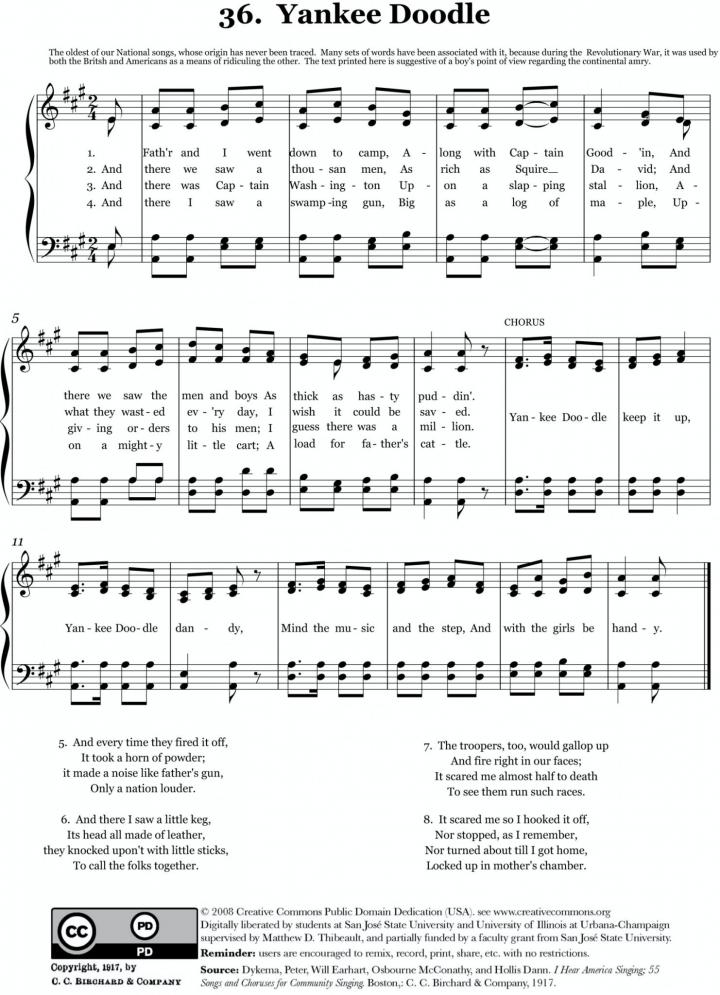“Nankey doodle came to town, riding on a pony. With a feather in his hat, upon a macaroni.” Recognize these lyrics? Once a children’s rhyme, the words changed over time from a political taunt to a battle hymn during the American Revolution! Learn more about this patriot tune (and what is a macaroni, anyways?).
How Did Yankee Doodle Come to Be?
Not many are aware that the melody for “Yankee Doodle” was once upon a time (as far back as Shakespeare, in the 16th century) a nursery rhyme sung to children.
Despite these gentle origins, the tune—as well as the style of words—was eventually in vogue in a version composed in derision, one theory goes, of Britain’s Oliver Cromwell, about a century and a quarter before the American Revolution.
That treatment began this way:
Nankey doodle came to town
Riding on a pony
With a feather in his hat,
Upon a macaroni.
Here’s what few of those words meant in those days:
- “Nankey” was “nankeen,” a sturdy, yellow–brown, cotton fabric used in work clothes.
- A “doodle” in old English dictionaries was a “sorry, trifling fellow.”
- A “macaroni” was defined as a knot on which a feather was fastened.
Later, a macaroni was a hairstyle effected by a group of American loyalists who were mimicking the wealthy British encamped in New York. The British had picked up the hairstyle from foppish young students at Oxford University in England, who had formed a club named after the famous pasta dish of the same name. The Macaroni was a toupée that rose so high above the forehead that in order to lift the tiny tricorn hat that sat on top of this hairpiece, the dandy had to use his gold-tasseled walking stick.
The wearer of one was also called a “macaroni”—the swell (dude) of his day. He wore clothes so ornate—be–ruffled, be–frogged, and festooned, with a bunch of fresh flowers in his buttonhole—as to make 20th-century “flower children” look drab. If the ducktail haircut of the 1950s or later male long–hairstyles seem absurd, what of the “staircase,” the “snail back,” the “royal bird,” and the “she-dragon” of Revolutionary days, worn by this same avant-garde?
When disaffected Americans tried to imitate their British cousins, they had neither the money nor the materials to get the proper effect and looked ludicrous to British eyes in their homespun uniforms.
A surgeon in the British army at Albany in 1755, a certain Dr. Schuckburg, composed a song to the tune, now known in New England as “Lydia Fisher’s Jig”:
Lucy Locket lost her pocket;
Lydia Fisher found it.
Not a bit of money in it,
Only binding round it.
He meant to deride the uncouth appearance of the poverty-stricken and ill–equipped New England troops assembled there, so he called it “Yankey Doodle” instead of “Nankey doodle.”
Yankee See, Yankee Do
The melody was popular with the British as martial music, and when, in 1768, British troops arrived in Boston Harbor, what we know as “Yankee Doodle” was the tune that they played. The change in spelling to “Yankee” was not made until after the Revolution.
Dr. Thatcher, in his Military Journal, writes that Jonathan Hastings, a farmer from Cambridge, Massachusetts, who was living at around the time of 1713, used “yankee” as a favorite cant (slang) word to express excellence, as in a “yankee good horse” or “yankee good cider.” Students at Harvard University, hearing Hastings use the term so much, began calling him “Yankee Jonathan.”
As with other cant words, this spread and finally came to be applied to New Englanders as a term of reproach. (Some suppose the term to be the Native American corruption of the word “English”: Yenglees, Yangles, Yankles, and, finally, Yankee.)
However, with the passage of centuries, the meaning reversed itself. What started out as a derisive word came to connote certain virtuous qualities, especially when coupled with another term, such as integrity, thrift, stick-to-it-iveness, and ingenuity.
To the dismay of the British, their song, derisive in intent, became a battle hymn. It was adopted by the rough-and-ready spirits of the American army for their own and smote the delicate ears of the British in defeat on many occasions. When nearly 6,000 British, German, and Hessian soldiers laid down their arms to 13,000 American soldiers and militia at the surrender of British General John Burgoyne to English-born General Horatio Lloyd Gates at Saratoga, they did so to the lively tune of “Yankee Doodle.”
Thus, the British learned that fancy uniforms do not make the soldier, nor does name-calling disturb him!
See the full text of “Yankee Doodle” here:

Comments